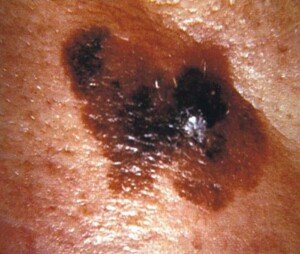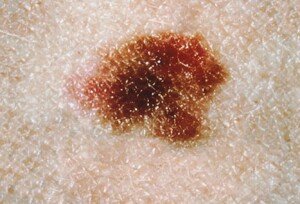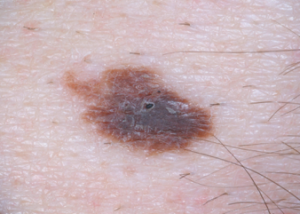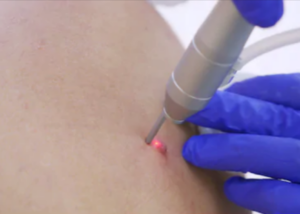Did a mole recently get burnt – dark scabbing or crust on it – after undergoing laser hair removal?
This can be an unnerving sight, especially if it involves multiple moles.
You may already know that one of the signs of melanoma developing in a mole is that the mole is “crusty” or “crusting.”
Another possible sign is that the mole is darker.
When a mole is burned from the laser, it will look burned or even charred.
This appearance can make someone immediately think of melanoma.
Can accidental laser exposure to a mole cause melanoma?

Melanoma. 2 CDC, Carl Washington, MD, Emory Univ. School of Medicine, Mona Saraiya, MD, MPH
“It is highly unlikely for a mole burnt from laser hair removal to become melanoma,” says Alpana Mohta, MD, DNB, a dual board certified dermatologist who specializes in clinical and aesthetic dermatology.
“Melanoma is a type of skin cancer that arises from the pigment-producing cells (melanocytes) in the skin.
“Moles, on the other hand, are benign (non-cancerous) growths that are made up of melanocytes.
“Melanoma arises after prolonged exposure to harmful ultraviolet (UV radiations).
“But, the UVA and UVB wavelengths found in sunlight, which are known to damage cellular DNA and result in skin cancer, are not used in laser therapy.”
The Laser Is Drawn to Dark Pigment
Dark moles are more likely than lighter moles to be burned by a laser.
This is because the laser is drawn to the darkest areas.
“Laser hair removal works by targeting the melanin (pigment) in the hair follicles with a highly focused beam of light,” explains Dr. Mohta.
“This can damage the surrounding skin cells, including the melanocytes in moles.
“Although, hair removal lasers contain infrared radiations which doesn’t cause skin cancers.”
What if an atypical mole is burned?
“However, if a dysplastic mole is damaged by the laser, it is possible for the damaged cells to undergo changes that can lead to melanoma,” says Dr. Mohta.
“But I would emphasize again that the risk of such an event is considered to be very low.”
There have been no studies on whether moles (dysplastic/atypical or not) have eventually become malignant following injury from a laser during the hair removal process.
It’s also possible that melanoma can develop in a previously burned mole – by sheer coincidence rather than as a result of past burning and scabbing by a laser pulse.
Another point to consider is that the DNA mutations from an external insult (such as sun exposure) that lead to malignant transformation take many years to occur.
Though a mole with melanoma can visibly change over a short course of time (increase in size, change shape, develop erratic edges, become multi-colored or crusty), the DNA mutations that had led to this were years in the making.
Thus, if you see evidence of burns on your moles – even if they’re noticeable darker, have texture that wasn’t there before and appear to have tiny black scabs – there is absolutely no need to rush to a dermatologist to have them removed and biopsied.
If, from a cosmetic perspective, you choose to have them removed, they should still be biopsied – simply because ANY mole that’s removed, regardless of reason, should always be biopsied.
Laser Hair Removal Deemed Safe
“It is important to keep in mind that laser hair removal is considered a safe and effective way to remove unwanted hair,” says Dr. Mohta.
“The vast majority of people who undergo this treatment do not develop any complications, including melanoma.
“Although, it is always important to carefully follow the instructions provided by your doctor or the technician performing the procedure, and to carefully monitor your skin for any changes or abnormalities after the treatment.
“If you notice any changes in your moles, or if you develop any new moles or other skin changes, it is important to consult with a doctor right away.
“They will be able to examine your skin and determine whether any further testing or treatment is necessary.”
What is a dysplastic or atypical mole?

Dysplastic nevus (mole)
Also known as a dysplastic nevus, this is a mole that’s more likely than typical moles to ever develop melanoma.
This increased risk is not a guarantee, though. It simply means that the risk is higher than in common or regular moles.
Your dermatologist can tell you if any of your moles are dysplastic. They’re usually large and asymmetrical.
 Dr. Alpana Mohta is a dual board certified dermatologist and owner of dralpana.com. Her areas of interest include clinical dermatology, dermatopathology and dermatosurgery. She has over 85 research publications in numerous journals. Apart from her regular medical practice, she is also a medical writer, reviewer and advisor for many companies.
Dr. Alpana Mohta is a dual board certified dermatologist and owner of dralpana.com. Her areas of interest include clinical dermatology, dermatopathology and dermatosurgery. She has over 85 research publications in numerous journals. Apart from her regular medical practice, she is also a medical writer, reviewer and advisor for many companies.
 Lorra Garrick has been covering medical, fitness and cybersecurity topics for many years, having written thousands of articles for print magazines and websites, including as a ghostwriter. She’s also a former ACE-certified personal trainer.
Lorra Garrick has been covering medical, fitness and cybersecurity topics for many years, having written thousands of articles for print magazines and websites, including as a ghostwriter. She’s also a former ACE-certified personal trainer.
.










































